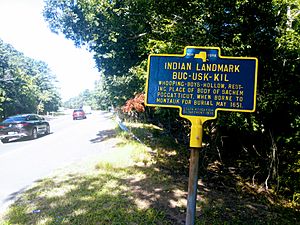Poggatacut (sachem) facts for kids
Poggatacut (1568 – 1651) was an important Native American leader, also known as Youghco or Poggatticut. He was a sachem, which means a chief, of the Manhasset people. They lived on Shelter Island, New York. Poggatacut was the older brother of Wyandanch, who was also a powerful sachem of the Montaukett people.
In 1639, Poggatacut and his wife, Aswaw, gave possession of Gardiners Island to a man named Lion Gardiner. This was part of an agreement where they exchanged land for goods and an alliance. By 1644, Poggatacut had brought together several Native American groups. These included the Corchaug, Shinnecock, Manhassets, and Montaukett tribes. After uniting them, he moved to his home on Shelter Island. He then passed control of these tribes to his younger brother, Wyandanch. Poggatacut was known as the "Sachem of Paumanacke," which was the Native American name for Long Island. This title gave him the power to make important agreements for the Montaukett people.
Early Life of Poggatacut
Poggatacut was the son of Mongotucksee Longknife, who was the Sachem of Montaukett. His mother was Quashawan, from the Mohawk and Montauk tribes. Poggatacut had many brothers and sisters. His family was like a royal family among the Native American tribes. They had rivals, even tribes as far away as the Narragansetts in Connecticut. The Montauk Tribe was sometimes allied with, or paid tribute to, the Pequots, who were also their enemies.
Pequot War and Poggatacut's Legacy
The Pequot War (1636–1638) was a very difficult time for the Pequot people. Many of them died because of conflicts with European settlers and other tribes like the Narragansetts. This war ended the Pequots' power on Long Island. After the war, the Narragansetts wanted to completely defeat the Montaukett tribe. To protect his people, Poggatacut decided to form an alliance with the European settlers and Lion Gardiner.
By 1648, Poggatacut was the sachem of Shelter Island. He often traveled from his home on Sachem’s Neck to visit other tribes. It was during one of these trips that he passed away in 1651. His body was carried back to Montauk for his funeral. The procession stopped at a special place called Buc-Usk-Kil. This spot was on the road between Sag Harbor and East Hampton.
Native American stories say that where Poggatacut's head rested, there was a shallow hole in the ground. It was about 1.5 feet deep and became known as the Sachem's hole. For many years, this place was sacred to passing Native Americans. For about 200 years, tribes would stop there and clear away any twigs or leaves that had fallen into the hole. Sadly, in the 1950s, the road (NY 114) was widened, and the Sachem's hole was covered up.
Later, by 1663, the town of East Hampton passed laws that kept Native Americans out of the town. This was because of a smallpox sickness that greatly affected the Montaukett people. Grand Sachem Wyandanch, Poggatacut's brother, had united 13 tribes. He moved his people closer to the white settlers to find safety. By the end of the 1800s, only a small number of Montaukett families remained in the area.
Buc-Usk-Kil Nature Preserve
In 2001, the trustees of East Hampton created the Buckskill Nature Preserve. This preserve includes 140 acres of town land and 170 acres of pine barrens owned by Suffolk County. The town realized that protecting the water under these pine barrens was important. It helped to refill the town's water supply. Buc-Usk-Kil is an Algonquin word that means 'resting place'. The starting point for this nature preserve is on NY 114, between Stephen Hands Path and Daniels Hole Road.


